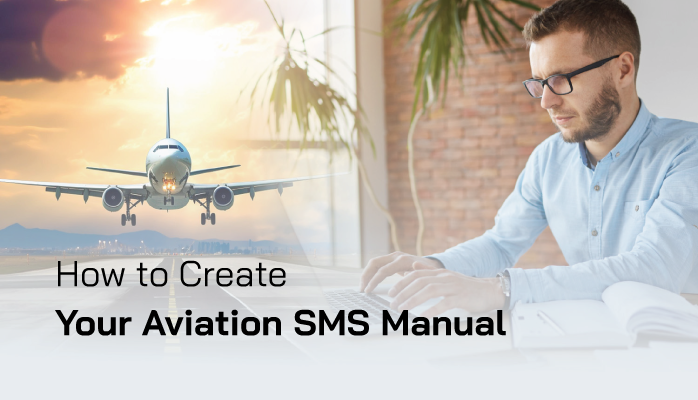
Create Aviation SMS Manuals
Creating an aviation Safety Management System (SMS) manual is a critical task for safety managers, consultants, and accountable executives striving to meet International Civil Aviation Organization (ICAO), Federal Aviation Administration (FAA), or European Union Aviation Safety Agency (EASA) standards.
A well-crafted SMS manual not only ensures regulatory compliance but also fosters a proactive safety culture, reducing risks across operations. For small operators like flight schools or large airlines, the process can seem daunting, often taking 6–12 months without proper tools.
This guide outlines five actionable steps to develop an ICAO-compliant SMS manual, leveraging templates and software to cut development time by 30–50%, as demonstrated by a European airport’s implementation.
Step 1: Understand the Purpose and Structure of an SMS Manual
An SMS manual serves as the backbone of an organization’s safety management system, documenting policies, procedures, and processes to manage safety risks. According to SKYbrary’s SMS overview, it aligns with ICAO’s four pillars: safety policy, safety risk management (SRM), safety assurance, and safety promotion. The manual must address regulatory requirements, such as those outlined in FAA Advisory Circular 120-92B, while being tailored to the organization’s size and complexity.
Start by reviewing the table of contents (TOC) as defined in ICAO Annex 19 or FAA Part 5. A typical SMS manual includes sections on safety policy, organizational structure, risk management processes, safety assurance activities, and safety promotion strategies. For a detailed breakdown, refer to What is an SMS Manual. This resource provides clarity on mandatory components, helping new safety managers at small fixed-base operators (FBOs) or experienced professionals at airlines structure their manuals effectively.
Key actions:
- Download a customizable SMS template to map out sections.
- Identify applicable regulations (e.g., FAA Part 5 for U.S. operators or EASA Part-ORA for European operators).
- Engage stakeholders, including the accountable executive, to ensure alignment with organizational goals.
Pro Tip: Start with a scalable aviation SMS database software product that includes all elements required in an SMS, such as SMS Pro. This saves rewriting your SMS manual and getting it approved "again." SMS Pro also includes an SMS manual template tailored to SMS Pro's robust and complete features and workflows.
Step 2: Conduct a Gap Analysis to Assess Compliance
Before drafting the manual, perform a gap analysis to identify discrepancies between current practices and regulatory requirements. This step is crucial for consultants supporting maintenance, repair, and overhaul (MRO) organizations or utilities, as it highlights areas needing improvement. A gap analysis involves comparing existing safety processes against ICAO Doc 9859 standards or FAA Part 5 requirements, available in ICAO Doc 9859.
Tools like SMS Pro's Gap Analysis module can streamline this process by providing checklists and automated assessments. For example, a small flight school might discover it lacks a formal hazard reporting system, while a global airline may need to refine its safety assurance audits. Document findings in a report to prioritize updates, such as developing a non-punitive reporting policy or defining safety performance indicators (SPIs).
Key actions:
- Use a gap analysis checklist to evaluate all SMS components.
- Involve department heads to validate findings across operations.
- Plan corrective actions to address identified gaps, setting timelines for compliance.
Step 3: Draft the Safety Policy and Objectives
The safety policy statement, a core component of the SMS manual (TOC 1.3), establishes the organization’s commitment to safety. It must be signed by the accountable executive and include non-punitive reporting and fatigue management policies, as outlined in TOC 1.3.4–1.3.5. For guidance, see How to Write a Non-Punitive Reporting Policy. A strong policy ensures leadership buy-in, which is critical for 95% of successful SMS implementations.
Define safety objectives that are specific, measurable, achievable, relevant, and time-bound (SMART). For instance, a Part 135 operator might aim to reduce runway incursion risks by 20% within a year. Link these objectives to key performance indicators (KPIs), such as the number of hazard reports submitted monthly. The Safety Objectives resource offers templates to craft measurable goals, saving time for busy safety managers.
Key actions:
- Write a safety policy statement reflecting organizational values.
- Develop SMART objectives tied to operational risks.
- Secure accountable executive approval to formalize the policy.
Step 4: Define Roles, Responsibilities, and Processes
Clearly outlining roles and responsibilities (TOC 1.4) ensures accountability across the organization. The accountable executive, safety manager, and frontline employees must have defined duties. For example, the accountable executive oversees SMS implementation, while the safety manager conducts risk assessments. Refer to Distinguishing Between Responsibility, Authority, and Accountability for practical examples.
Document processes for safety risk management (SRM) and safety assurance (SA). SRM includes hazard identification, risk assessment, and mitigation, while SA covers audits, performance monitoring, and corrective actions. These processes should align with operational needs, whether for a small FBO or a large airport. A European airport reduced compliance risks by 80% by using standardized templates to clarify roles, as noted in client case studies.
Key actions:
- Create an organizational chart linking roles to SMS tasks.
- Document SRM and SA processes with step-by-step procedures.
- Train staff on their responsibilities to ensure compliance.
Step 5: Implement, Monitor, and Refine the Manual
Once drafted, the SMS manual must be implemented, monitored, and regularly updated. Use software like the Auditing System to conduct internal audits, ensuring compliance with FAA, EASA, or ICAO standards. Regular audits, recommended annually, help identify areas for improvement, such as outdated policies or incomplete risk assessments. For tips, see How to Conduct Internal SMS Audits.
Engage employees through safety promotion activities, such as newsletters, safety meetings or safety surveys, to maintain a robust safety culture. Monitor KPIs, like the percentage of resolved safety reports, to track performance. A client airline improved safety metrics by 20% by using automated KPI tracking, demonstrating the value of continuous monitoring. Update the manual as regulations evolve or operations change, ensuring it remains a living document.
Key actions:
- Distribute the manual to all relevant personnel or host it in your SMS database software for easy access.
- Schedule annual audits to verify compliance.
- Revise the manual based on audit findings and operational feedback.
Common Pitfalls to Avoid
Safety managers often face challenges, such as underestimating the time required or failing to involve leadership. Avoid these pitfalls:
- Lack of Stakeholder Buy-In: Engage the accountable executive early to secure resources.
- Generic Templates: Customize templates to reflect operational specifics.
- Not Changing Templates:Auditor horror story seeing another company's name in their SMS manual.
- Neglecting Updates: Review the manual annually to stay compliant.
By following these steps, organizations can develop a compliant SMS manual in a week or two, not years. A European airport, for instance, used SMS Pro’s templates to save 6–12 months, achieving full ICAO compliance.
Conclusion and Call to Action
Writing an aviation SMS manual is a complex but achievable task with the right approach. By understanding the manual’s purpose, conducting a gap analysis, drafting clear policies, defining roles, and maintaining ongoing monitoring, safety professionals can ensure compliance and enhance safety. Tools like SMS Pro’s gap analysis and auditing modules streamline the process, making it accessible for operators of all sizes.
Ready to start? Download our free SMS resources or request a demo to explore how SMS Pro can simplify your SMS manual creation. Act now to reduce development time and strengthen your safety program.





